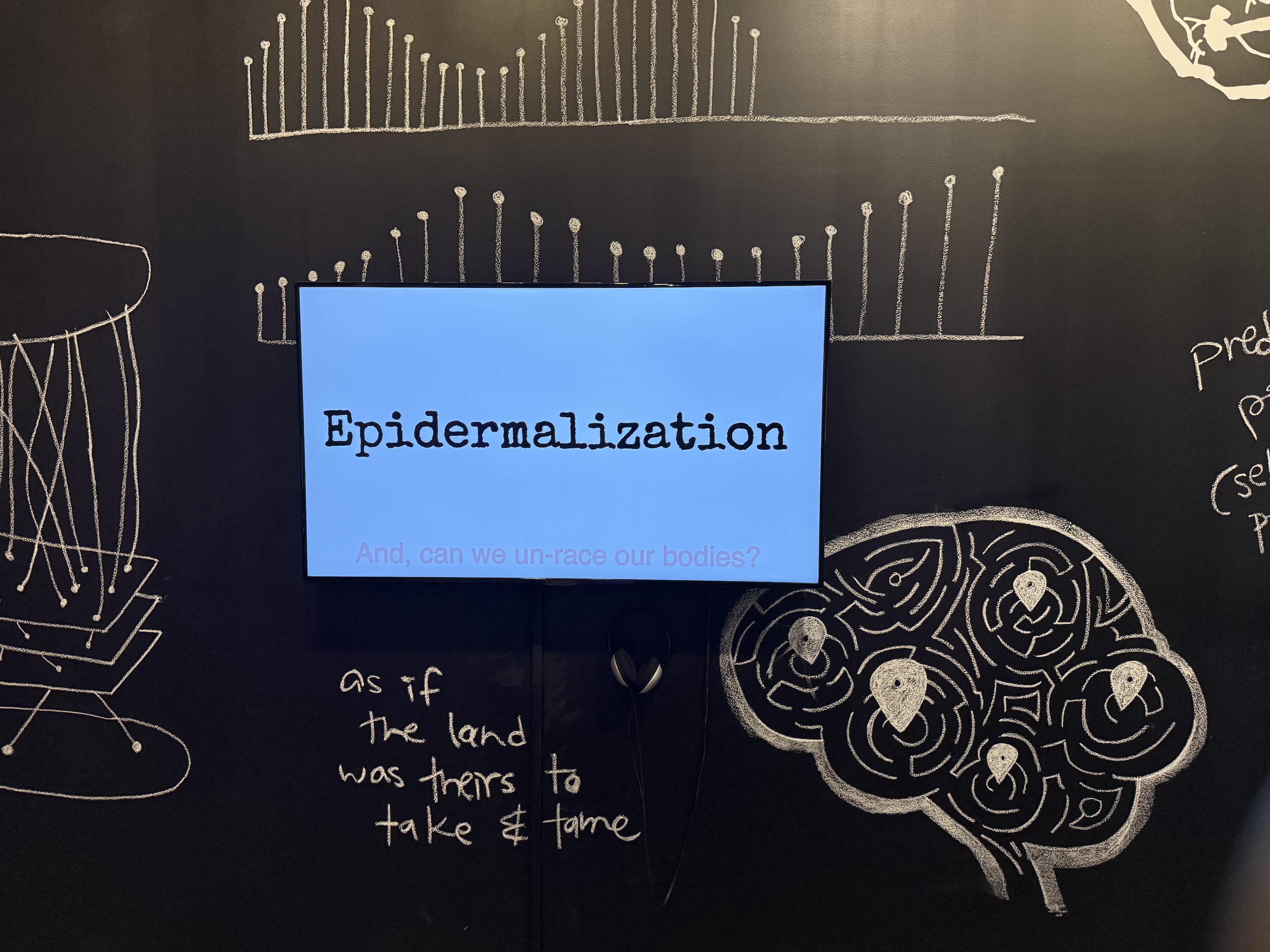Working Knowledge: Shared Imaginings, New Futures at the Bronx Museum is a living laboratory for contemporary art, community building, and new media. Through interactive works, artists who are actively engaged in inclusive modes of knowledge production invite the public to ponder critical themes like socially responsive design, intergenerational memory, and ancestral wisdom. United by a focus on ecological and technological ecosystems in the Bronx and beyond, these works employ coding, gardening, listening, and dancing.
Working Knowledge begins with installations that grapple with sustainability, both ecological and communal. Mary Mattingly’s “Rooted” (2024–25) is a multi-tier shelving unit teeming with plant life. The glass jars and terrariums contain lush flora from New York, particularly plants that might be able to thrive as climate change impacts the city. At the “Oral Futures Booth” (2025), designed by Black Quantum Futurism (Rasheedah Phillips and Camae Ayewa), visitors can record reflections and desires for the place they call home, to take part in building a “quantum time capsule.” The artists define a quantum time capsule as a multitemporal portal for communicating with ancestors and future generations.

Printed on the wall along the ramp heading to the next gallery is Lynne Yun’s “Concourse” (2025), a typeface designed in collaboration with the Bronx Museum’s Teen Council inspired by the Bronx’s visual landscape. The curves and angles of the font parallel the hills and valleys that make the layout of the Bronx unique compared to other flatter and more grid-like boroughs. The upper gallery contains fascinating, interactive works such as Stephanie Dinkins’s “BronxBot” (2025), which utilizes an AI chatbot to have conversations about the Bronx with visitors. Nearby, Melanie Hoff’s “Dance Poem Revolution” (2024) encourages participants to generate abstract, political poems through stepping on a Dance Dance Revolution dance pad. The poems are related to what Hoff and community members imagine as revolution in the Bronx, and are generated through open-source, movement-triggering software. Words like “ashes,” “youth,” “violence,” and “pain” are among the terms the artist sourced collaboratively from community members. Such uses of creative coding and AI in both works point to the possibilities of new media in recent contemporary art.
On the adjacent wall, “The Bronx Dictionary of Dark Matters” (2020–ongoing), an installation by artists Zainab Aliyu and American Artist, and the School for Poetic Computation, transforms a large, chalkboard-like wall into an expansive mind map of critical terms, drawings, philosophies, and speculative possibilities related to race, policing, surveillance, immigration, and other urgent social justice issues. At the heart of the installation is an interactive computer that invites visitors to select a key term and contribute their own definitions. These dynamically appear on a screen embedded in the wall, becoming part of the ever-evolving dictionary of “dark matters” (a reference to Simone Browne’s groundbreaking text on racialized surveillance). Like the dark matter in physics, which is invisible yet exerts real force, ”dark matters” describes the often-obscured forces of race and power that profoundly influence society.

In the final gallery space, several works serve as brilliant odes to Bronx lifeways. Azikiwe Mohammed’s “El carrito de comida de DeAndre / DeAndre’s Food Chart” (2025) draws inspiration from the everyday fruit carts found along Grand Concourse, a major thoroughfare in the South Bronx. Nearby, visitors can sit on a pile of decorative pillows to experience “Cosmologyscape”(2024), an ongoing collaboration between Kite and Alisha B. Wormsley. The work features a projected digital quilt composed of dreams shared by visitors, blending Lakota visual iconography with Black American quilting traditions.
Ari Melenciano’s “Cosmeage” (2025) presents a filmic projection of digitally animated, improvised choreography, offering a new media interpretation of pan-African performance traditions. The title, a portmanteau of “cosmos” and “lineage,” fittingly reflects the overarching spirit of the exhibition, which explores the intersections of ancestral knowledge and contemporary digital practices.
While the environmental impact of AI reminds us to use such technologies with care, Working Knowledge thoughtfully engages with these tools without glorifying them. Most importantly, the exhibition is deeply attuned to the Bronx community it emerges from — an attentiveness that greatly enhances its significance. Across the exhibition, each artist takes seriously the particular site — communities, landscapes, and politics — of the Bronx as a generative source of inspiration and collaboration.




Working Knowledge: Shared Imaginings, New Futures continues at the Bronx Museum (1040 Grand Concourse, Concourse Village, The Bronx) through July 6. The exhibition is a Visions2030 Project in collaboration with the Bronx Museum and curated by Vera Petukhova.

